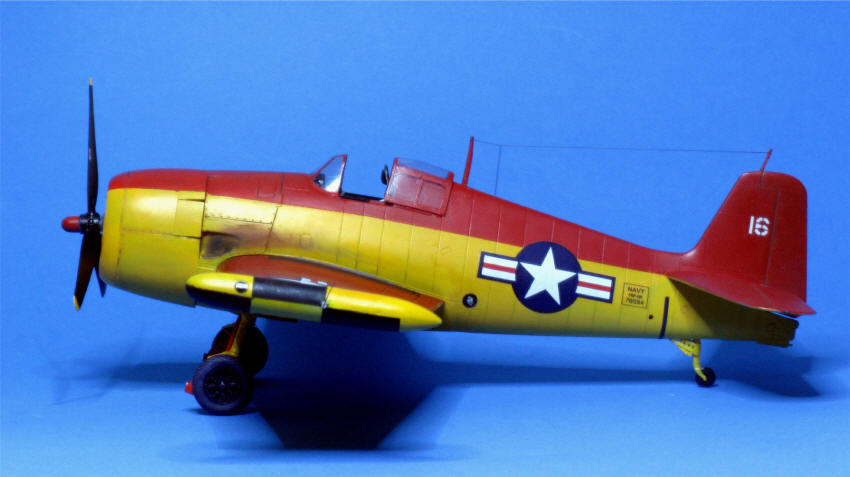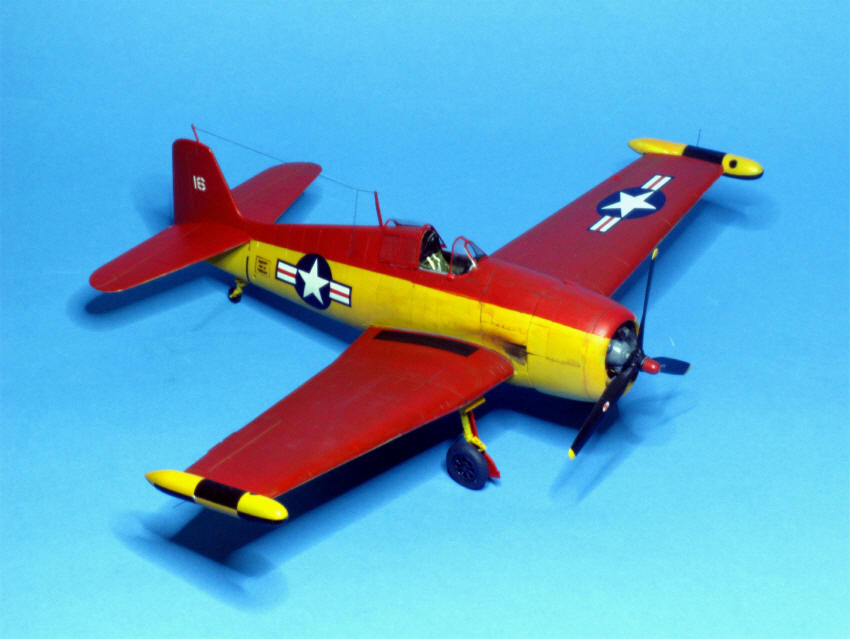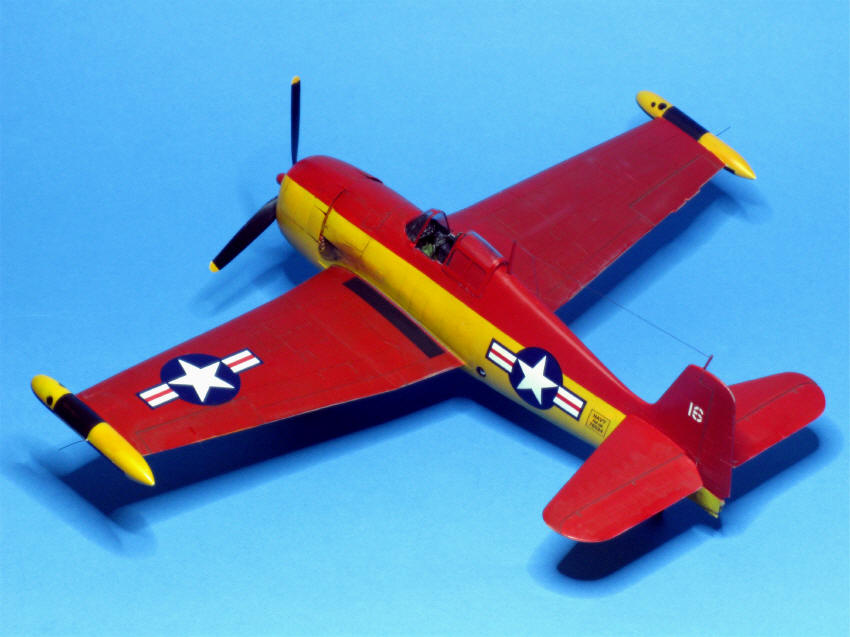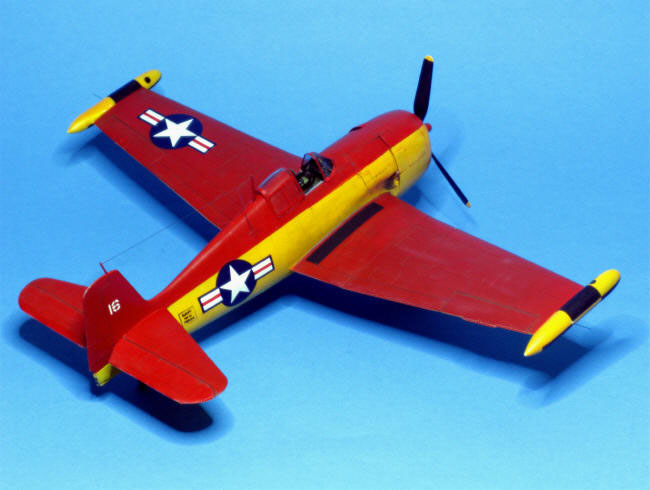|
|
Grumman F6F-5K drone 1951, Otaki 1/48 plus scratch |
|
| 1. Plastikmodellbauclub Nürnberg e.V. |
| back to model pages | back to 1. PMCN e.V. | |
| Model and photos by Wilfried Eck | ||
|
|
Grumman F6F-5K drone 1951, Otaki 1/48 plus scratch |
|
 |
 |
 |
| Detailing
of the Hasegawa cockpit isn't bad so I left it as it was. The seat belts are
strips of thin sheet aluminum, the bulges half round plastic, painted buff. Please notice: Seat belts sliding over a horizontal bar was usual on all USN wartime aircraft!). It should look like in the photo at right. Colours see below. As the photo supplied in Sqn.Signal shows a F6F-5K the kit -3 canopy hood was useless. A new one was made in the usual way, the windshield resting in a groove. Detailed sketches how to make canopy hoods see ABC page C.
|
|
||
|
Sorry, no photo: The inaccurate
Hasegawa motor cowling was modified. The air intakes were removed and thin
layers of plastic glued in until the required thickness was achieved. Then
sanded to shape. With two wedges glued inside the whole affair was complete,
no aftermarket resin part needed. The not so well detailed Hasegawa motor got a more convincing appearance by adding wire ignition cables. Body colour "Engine Gray".
|
|
||
| Making wing tip pods was easy.
Two rocket pods of the (guessed) right diameter from the spares box, the
rear half being built by Polyester* car repair putty, sanded to shape when
hard. To make centering easier the rocket pod had received a central spine
in the rear, made out of surplus sprue. Two thin tubes with central steel wires for strenght helped to align the pods horizontally and strengthen the joint. As the real F6F-5K had horizontal aerials sprouting from the tip pods a hole was bored into each (centered longitudinally and horizontally), then a bristle from a broom, cut to appropriate length was glued in. * In case Polyester putty is unknown: It's of dough like consistence and gets hard after 4 % hardener has been added (stir well). Hardening is gradually, so after a few minutes it can be roughly shaped with a sharp knife, after thorough hardening it can be sanded like wood. Correcting a mistake or filling some hole is easy as well: Simply add another layer. In Germany these tins and the necessary small tube hardener are sold in the car repair shop.
|
|
||
As one can see in the original photos both Hellcats had an elongated tail gear. Also the real thing doesn't show an oblique massive block (seen in most kits), thin holed sheet metal acting as a brace instead. |
|
||
Concerning the cockpit colors a modellers myth knows "Interior Green" (ANA 611). But this is only half the truth. While being ordered Dec. 21th 1942 aircraft already painted in the previously used paint were to be left as they were; to make things worse manufacturers were allowed to use up their paint stocks. So even in 1944 you could see TBF Avenger interiors painted "Bronze Green". In effect: The color depends on the time the aircraft was built. In Oct. 10th 1944 SR-15e ordered all cockpit surfaces above the lower edge of the instrument panel to be painted Black (FS 37038). I think most aircraft appearing in the later stages of war were painted this way (check F4U-1D's!), and accordingly as the aircraft shown wasn't an early Hellcat I used "Interior Green" for the lower area and Black for those above (Revell paints).
Concerning the outside colors Sqn.Signal states red for the upper sides, rudder and yellow undersides, tip tank checks black. Checking the photo closely I came to the conclusion that the fin of the vertical stabiliser must have been red too, on the other side I couldn't see any difference between the lower and uper side of the wings. But Mr. Esposito who furnished this photo should have known better so I used the paint information given there. I bet "yellow" wasn't some indifferent kind of yellow but the official colour for trainers and propeller tips, "Orange Yellow" (FS 13538), Upper sides not scarlet or other kinds of red, but definitely "Insignia Red", FS 11136.
In the photo the main landing gear showed several shades of gray, the legs of the landing gear being the same colour as the sides of the aircraft ( = Orange Yellow). The wheel covers appeared darker, but not as dark as the hub of the wheel. As the colour of the vertical stabiliser came close to the former shade I used "Insignia Red". The wheels were obviously taken from a standard Hellcat, the hubs being painted "Sea Blue".
Markings partially spares or printed on clear decal paper.
In the real aircraft exhaust stains showed a merge of - from front to rear - dark brown, middle brown, dark gray, light gray. Trying to spray this is a futile effort, especially as due to aerodynamic forces the exhaust gases don't get broader but narrower instead. I used pastels, the appropriate colour being applied by use of a cotton bud and merged by careful wiping. No "ageing" or highlighted panel lines as in most areas the Hellcat had overlapping panels.
When the model was complete I remembered an article in AIR International (1979, 176). Well, I should have referrd to it earlier! The pods on the wing weren't tanks but camera pods instead (this seems plausible as a tank doesn't need so many fillig holes with black covers). Furthermore the photo showed a circular black speck behind/below the trailing edge of the wing. This was the opening for the camera of a F6F-5P photo plane. This aircraft was a photo drone! To make things worse the colours should be "Orange" over "(Insignia-) "White". This answers my guessing of upside the colour of the wings (same as below)- The camera opening and camera lens (dot of epoxy glue) could be made, but the model as such won't survive the next exhibition.
So much for Squadron Signal advice.
Real colours see "Originalfarben" in German page ABC-O
 |